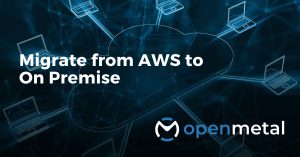
In this blog:
When SaaS providers consume large amounts of public cloud, a move to a hosted private cloud may reduce current AWS costs up to 50%. This can free up existing capital to be used for new SaaS growth.
A Penny Saved by Reducing AWS Costs is a Penny Earned
The launch of a new software-as-a-service (SaaS) company is exhilarating. It’s an energy drink-fueled race to get ideas out of one’s head and develop them into a simple product for testing, marketing, trials, user feedback. Then rinse and repeat. But despite the blood, sweat, and (honestly) money poured into the the formation and validation phases of the organization, there is nothing more satisfying than when product fit is achieved and the product is in demand. This is the moment that everything gets easier, right? No.
Once a SaaS provider enters the “growth stage” of their company, there is a whole new set of problems to overcome. Competitors begin to plot against you. Your talented DevOps team is now spending more time trying to manage the increasing alert notifications of troubleshooting tickets than working on new product features.
And, those cloud credits you may have been operating on to kick-start your business are coming due, or have already run out. And, the reality of those hosting costs is terrifying.
To top it off, your investors are looking more closely at your bottom line profits. Your SaaS growth has never been more successful. But, if you cannot cost-effectively reinforce your staff and operating resources, success can also be your downfall. This is a defining moment for your company.
It May Be Time to Rethink Public Cloud Costs
This is the moment that ideas like “lean” or operational efficiency start to take root. It’s time to begin establishing efficient processes, implementing growth-oriented staffing plans, and most importantly identifying ways to balance costs and maximize profits. A first impulse may be to raise more capital through additional series funding. And, this can be a completely reasonable direction to take. But, before you take on any more financial debt, there is one other opportunity right in front of you.
The total cost of hosting is typically the largest component of Cost of Revenue for a SaaS provider. Therefore it is one of the most significant liabilities of your company’s gross margin. But what if this liability was actually an opportunity to reclaim revenue to fund new resources? This does not mean just tightening the belt a little bit to reduce AWS costs. It means fundamentally changing the way you do cloud altogether.
You should consider utilizing Hosted Private Cloud for your SaaS operations. If you are serious about finding new efficiencies in your performance and costs, you need to keep an open mind about your options. After all, a penny saved is a penny earned.
The Cost Tipping Points to Watch
When your SaaS company was just starting out, public cloud was probably justified. You were just beginning to ramp up your operations and did not want to be committed to high infrastructure spends. Using single AWS VMs is an attractive and cost-effective approach. The expense of all the other things that go on around hardware is simply baked into the cost. Plus, those AWS credits that AWS provides make it so easy to spin up your initial clouds with little to no spend.
But with SaaS growth, you depend more on cloud resources. As your cloud environment grows (and/or those cloud credits run out), the high cost of individual VMs on AWS becomes very apparent. This is when the margins you gain from moving to a hosted private cloud easily justifies the cost to pay for all the parts around that VM.
When your public cloud spend hits $20,000 to $40,000+ per month, this is the critical tipping point when you can benefit from changing the way you do cloud. The article “Public vs Private Cloud: A Cost Tipping Point Guide for IT Professionals” presents a comprehensive cost comparison between public and private clouds. It also shows that when you arrive at this tipping point, you are most likely in a position to reduce AWS costs as much as 50% off your current cloud spend (sometimes more) by moving some or all of your cloud clusters onto a hosted private cloud. The majority of these cost savings can be reclaimed from a few common resources and operating process benefits delivered by a hosted private cloud platform.
Compute
In a previous article titled “Private Cloud Fundamental Advantage vs Public Cloud,” an idea was presented that public clouds are not really built to “fit ” unique compute application needs of most workloads. This same idea applies here when discussing compute, storage, and other resources.
For example, if you are running big math models that require a ton of access to CPU, but you plan to ship the data out, public clouds do not allow you to create a cloud that is primarily CPU and RAM with little to no disk. You would be forced to acquire resources you do not need to get the ones that you do need…resulting in unnecessary and wasted cost.
The dedicated servers that support hosted private clouds are more cost effective then public clouds when it comes to the per-unit expense of Compute and Storage. When you divide up the resources of a dedicated server into distinct CPU threads, RAM, and disk space resources, the cost of individual VMs with specified resources will cost less than an identical VM on a public cloud. On the public cloud, you are forced to pay for all of the resources of that cloud package. It comes down to workloads that do not fit common VM ratios in a public cloud.
Scaling also comes into play. Running compute workloads in your own cloud environment on dedicated servers allows you to horizontally scale your infrastructure with traditional flows of vertical scaling. Therefore, not only do you get a better value per core, but the horizontal scaling built into the hosted private cloud platform allows you to run your workloads more efficiently as well.
Lastly, because private clouds are hosted on dedicated servers assigned exclusively to your SaaS, hosted private clouds can offer options for customized hardware choices and configurations that directly fit your unique workload’s needs. By allowing more choice when it comes to type and performance specifications of desired hardware, monthly cloud costs can be driven down significantly over public cloud options.
Storage
Storage is another area that can benefit financially and in performance from having a better fit to your desired workloads. For instance, you may want to make modifications to your storage types to allow for a more highly available disk, and trust that whatever you have written there is going to be there. This requires a highly available system that is going to be distributed across multiple machines. But, that can result in an IO penalty.
Therefore, a lot of workloads, such as test applications that produce data, need validation, and are then destroyed, do not need HA storage. Rather, you’re going to want direct access to the drives because it is faster.
In many ways, the efficiency of storage on a hosted private cloud is about the speed of completing a job. As opposed to public cloud storage that is scattered out across multiple locations around the world, many hosted private cloud services often keep the object storage resources in close proximity to the compute capabilities of the supporting servers and network, greatly increasing productivity.
And like compute, dedicated servers underneath the hosted private clouds can also be tuned to fit the ratios needed by workloads for storage advantages. For instance, dedicated servers allow for different blends of storage types such as Ceph Erasure Coding which can offer up to 85% more storage efficiency. You can even deploy additional dedicated servers into your hosted private cloud environment just to support expanded VMs and storage workloads vs having to purchase unnecessary or unwanted public cloud resources that are built into their packages.
Egress
Let’s first clarify that bandwidth is not necessarily a hosted private cloud vs public cloud issue. Bandwidth is bandwidth, regardless of the type of cloud. But for the purpose of comparing hosted private cloud to common public cloud costs, the costs typically associated with both are relevant to this discussion.
While most public cloud providers do not charge for ingress (incoming data), they have found that egress (outgoing data) offers an opportunity to make a healthy profit margin. By their own admission, AWS states on their own site that their egress costs range in the $0.08–$0.12 range per GB. If your SaaS operations are moving hundreds of terabytes (TB), or moving into a petabyte (PB) of data, it would not be surprising if your egress costs are hitting more than $80,000/month.
If you have very large egress bills, this can be one of the most immediate opportunities to reduce AWS costs. When you start looking at cloud alternatives, it should not be surprising that, to stay cloud-native, private cloud or hosted private cloud providers will present more reasonable bandwidth options at a more reasonable price.
Turning AWS Costs into Capital for SaaS Growth
When your SaaS growth needs additional resources to support demand, you need to make choices. You can continue to raise more borrowed capital, or you can use your current capital more wisely. Reduce AWS costs and reclaim up to 50% of that capital to hire more staff, buy more resources, and boost your SaaS growth. We know this can be done because OpenMetal has helped other SaaS companies do just this.
SaaS Provider Case Study
An AI chat platform SaaS provider came to OpenMetal with increasing AWS costs compounded by billing overruns that were making their development costs difficult to manage. OpenMetal engineers worked closely with them to build an OpenMetal Clouds solution and to begin moving their cloud clusters over on a defined schedule. Within the first six months, they were able to reduce AWS costs over 50%, which they used to reinvest in new staffing, resources and initiatives. Read the full story
How SaaS Providers Benefit from OpenMetal
OpenMetal eases the build and deployment of a hosted private cloud and transition from public cloud by offering something truly different. OpenMetal Cloud Cores allow you to gain the best of traditional public cloud, private cloud, and bare metal fused into an open source platform. Each hosted private cloud starts with an OpenMetal Cloud Core of three dedicated servers, Ceph storage, and the most commonly needed standard features right out of the box.
This new platform allows SaaS providers to gain the security, control, and utilization of a single tenant, private cloud environment. It’s cloud native, can still be deployed in 45 seconds, and scales with the convenience of public clouds.
- Hardware control (not management). Customize the root configurations of the hosting servers without the responsibility of managing those servers.
- Increased performance. Fine tune configuration settings to optimize your applications and workloads and increase overall operational performance.
- Optimized cloud resource utilization. Use the entire pool of server resources to achieve better control over compute and storage utilization.
- Security of a private cloud. Protect your data and applications in a single tenant environment that is not shared with any other users.
- Rapid deployment and scaling. Deploy and scale cloud resources with the convenience of public clouds.
Are You Open to Hosted Private Cloud Opportunities?
If you want to better understand the potential cloud savings, we can help. Schedule a consultation with our Cloud Team to do an initial assessment. It’s a no-pressure, complimentary discussion to understand your challenges and goals, review your current cloud bills, and identify any opportunities to reduce your spend. Reduce AWS costs and reclaim capital that you can use to fund new SaaS growth…rather than continuing to overpay large public cloud providers.
More on the OpenMetal Blog…

Private Cloud Fundamental Advantage vs Public Cloud
In this blog:
- Why does private cloud have such a significant advantage in cost and performance?
- Private Cloud vs Public Cloud Resource Efficiency for the Buyer!

Migrate From AWS to On Premise
Ready to explore the advantages of on-premise clouds alongside Todd Robinson, the President of OpenMetal? Under his guidance, delve into the details and acquire valuable insights on establishing your very own on-premise cloud. This information will empower you to seamlessly trans….Read More

OpenStack vs VMware: Cost Considerations
In this blog:
- Acquisition of VMware
- The OpenStack vs VMware Alternative
- The World is Beginning to Run on OpenStack
- Costs You Need to Understand
Test Drive
For eligible organizations, individuals, and Open Source Partners, Private Cloud Cores are free to trial. Apply today to qualify.
Subscribe
Join our community! Subscribe to our newsletter to get the latest company news, product releases, updates from partners, and more.


































